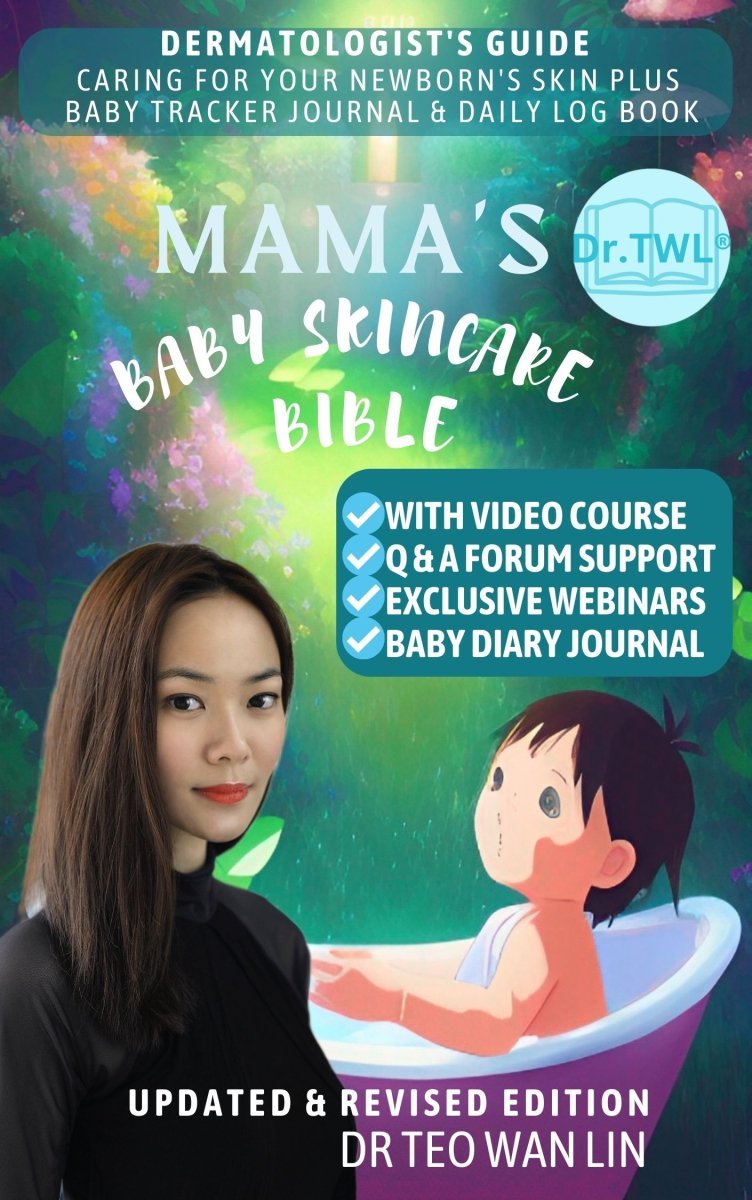Best Baby Skincare Set: Dermatologist Recommended For Newborns
The best baby skincare routine focuses on building the skin barrier from birth. The key principle to understand is that newborn skin is still developing and in fact is trying to adjust to its new environment. From being bathed by amniotic fluids within the womb (in-utero), baby’s skin is now exposed to airborne pollutants, VOCs, allergens, dust mites etc.
Baby Skincare Set By Dr.TWL
- Polysaccharide soap
[Glycerin] Humectant
[Glucomannan] [Tamarindus Indica Seed Gum]100% Plant Moisturiser
[Sodium Hyaluronate] [Jojoba Oil] Skin Barrier Hydration & StrengtheningMoisturising anti-inflammatory jelly soap with massage function suitable for a gentle relaxing baby bath. Coconut-derived lauryl glucoside emulsifiers free of SLS.
- Multi-CERAM™
Ultra intensive skin moisturiser for total skin barrier repair with pharmaceutical grade ingredients. Formulated with 100% safe and nourishing ingredients for pregnancy, breastfeeding mothers, infants and sensitive skin sufferers. - On-the-go Skin Cleansing Essence
Cleanses skin with natural rice brain and soy extracts. Fortified with lactobacillus ferment for the skin microbiome for acne prevention. Helps strengthen the skin barrier with added glycerin, hyaluronic acid and polyglutamic acid.
FREE GIFTS Whilst stocks last
Baby Beauty Bible (2023 Edition E-book) worth $4.99
Pack of reusable baby wipes (in baby blue and pink) $6
Plant-based laundry detergent X 16 sheets $55
Portable travel bag: CUIONS antibacterial pouch $55
BABY BEAUTY is the new baby skincare kit created for new mom’s, a complete all-in-1 baby skincare set for your newborn’s needs.
Welcome to Dr. TWL Pharmacy, your one-stop pharmacy for the whole family. Our in-house baby skincare brand Baby Beauty by Dr.TWL has just launched a newsletter! Subscribe here to get exclusives checklists delivered to your inbox fortnightly.
This feature is brought to you in conjunction with the launch of the BABY BEAUTY newsletter. For a limited time only, all BABY BEAUTY Skincare Set purchases come with a complimentary copy of Dr. Teo’s Baby Skincare Bible, the only handbook you need for your child’s skin health.
The best baby skincare caters to the differences between baby skin and that of an older child’s.
We begin with appreciating the fundamental differences between newborn and adult skin:
- Thinner & more fragile
- Not fully developed
- Still in adjustment phase (from in-utero environment)
- More permeable i.e. absorbs toxins more readily via epidermis
- Increased water loss to the environment (TEWL)
- Easily irritated by friction i.e. rubbing

1. Baby’s skin is thinner and prone to damage
Fragility is partly due to the fact that a newborn’s skin is not yet fully developed. There are also clear structural differences between baby skin and adult skin.
Baby’s Skin Cycle
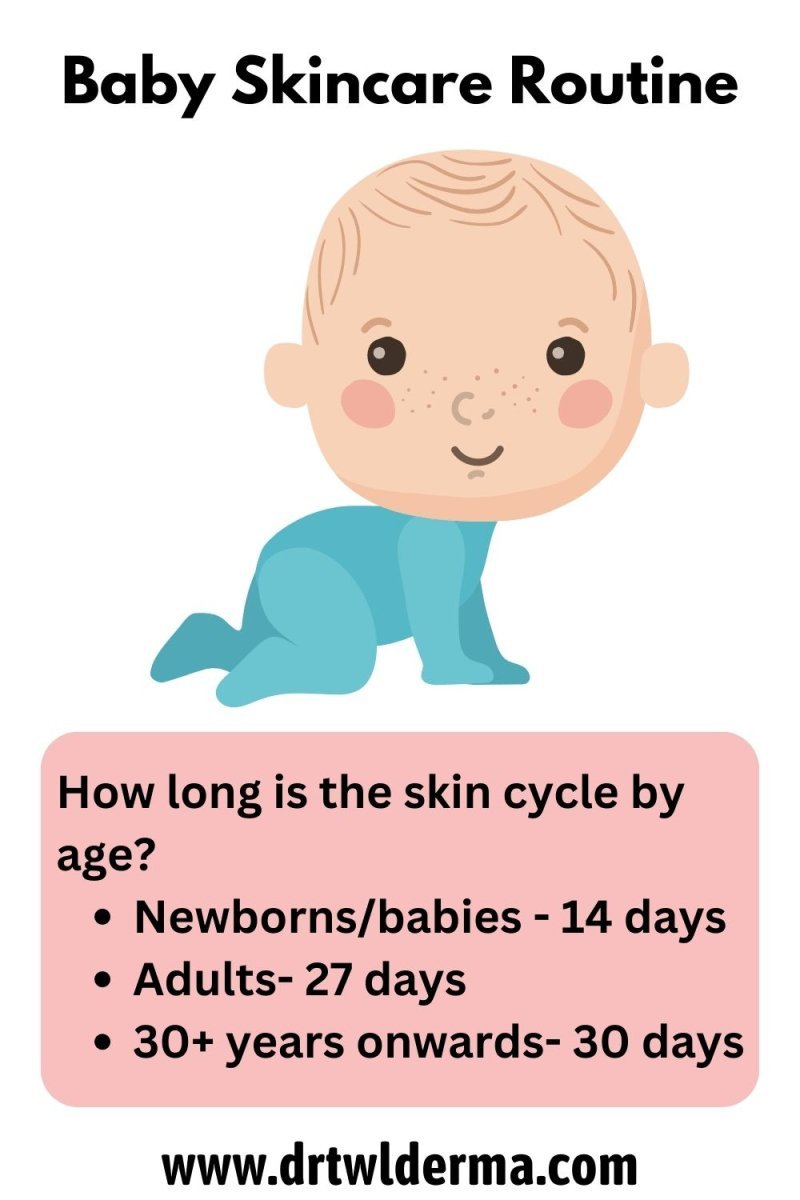
For instance, when examined under the microscope, the top-most layer of skin cells known as the corneocytes are much smaller. You may also have known that skin cells undergo a cycling process, which in adults takes an average of about 27 days. In babies, the skin cycle is shortened to about 14 days. As we mature, our skin cycle lengthens. This is why aging skin also appears dull—the dead skin cells accumulate for longer periods of time. Once we enter our thirties, the skin cycle increases in length to about 30 days.
How often does baby skin renew?
Baby skin renews much quicker than adult skin, which explains why scars heal well in babies and young children. The movement of cells from the bottom to the topmost layer is completed in about 14 days.
BEST BABY SKINCARE PRACTICES CHECKLIST 1
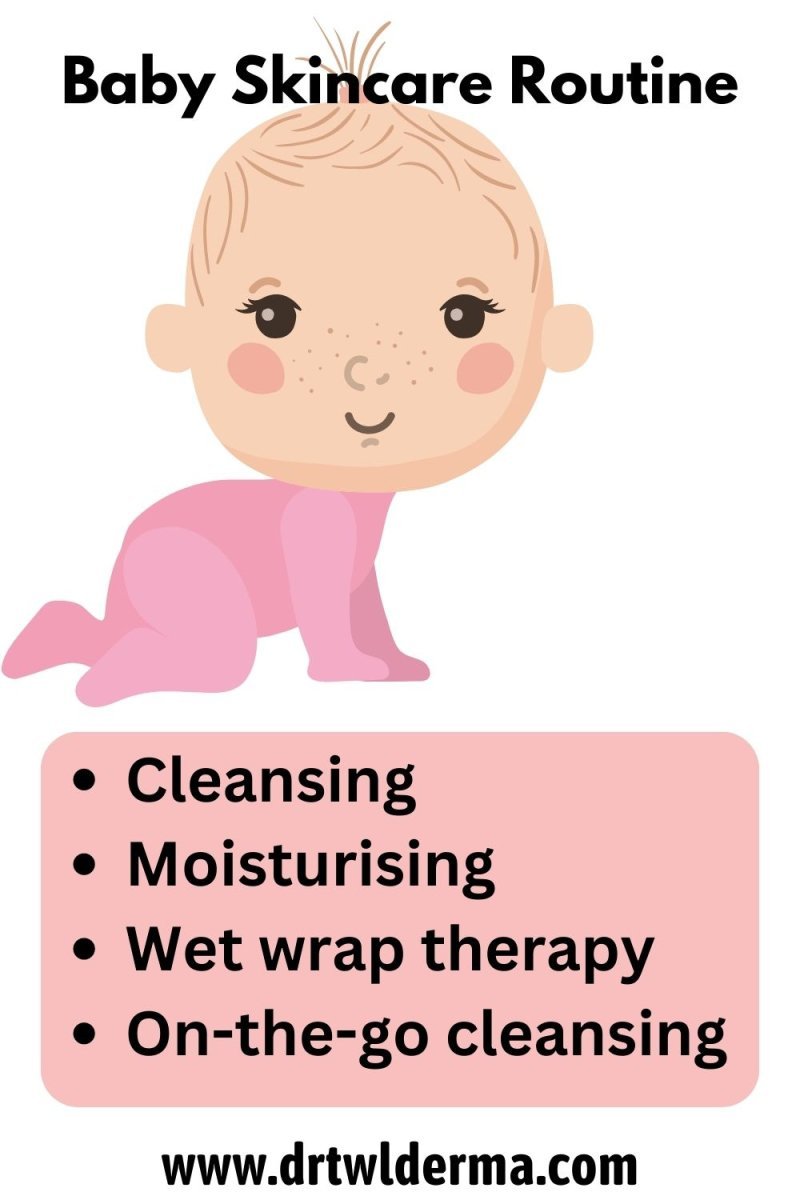
Cleansing
The best baby skincare routine begins with gentle cleansing. The polysaccharide soap is the first baby soap to combine tactile massage and gentle plant-based surfactants to nourish and heal newborn’s skin barrier.
Moisturising
The ideal baby moisturiser must be in the form of a cream and not a serum or a lotion. You see, a newborn’s skin is so delicate, primarily because it is not fully developed. There is no need to layer skincare because on its own newborn skin is already highly permeable. This means it absorbs everything that’s applied readily, unlike adult skin which benefits from skin layering as a way to create the ideal skin micro-climate.
@drteowanlin Ceramide Dominant Moisturisers #drtwl #dermatologist #dermatologistrecommended #skincaretips #babymoisturizer ♬ LoFi(860862) - skollbeats
Wet wrap therapy
Wet wrap treatment is a method of enhancing absorption of skincare recommended by dermatologists. This is pertinent for treatment of eczema, and can be a helpful principle when it comes to building a newborn’s skin barrier. Applying layers of wet clothing on a newborn with otherwise healthy skin may be a bit excessive—so unless your child has visible signs of eczema or you have been directed to do so by a dermatologist, it is sufficient to just apply it on damp skin i.e. immediately after cleansing, you don’t really need to fully dry skin before you apply moisturiser.
On-the-go cleansing
Drooling and soils are troublesome, but how one addresses the spills—that’s also very important for baby’s skin health. Saliva itself contains enzymes meant for digesting food, so when it is instead left on skin, it causes irritation. Especially since a newborn’s skin is thinner and more fragile. Using reusable soft microfibre towels are preferred for its high absorbency with minimal skin irritation. Use a botanical based hydrating essence to hydrate and cleanse skin in just 1 step.
How long is the skin cycle by age?
- Newborns/babies – 14 days
- Adults- 27 days
- 30+ years onwards- 30 days

Baby skin development after birth
Another characteristic of baby skin is that the dermis, the second layer of skin is much thinner than adult skin. The reason lies in the structure of the collagen fibres, which are much shorter in newborn skin. In addition, the reticular layer is absent, which is also what makes baby skin feel softer to the touch.
- More permeable i.e. absorbs toxins more readily via epidermis
- Increased water loss to the environment (TEWL)
- Easily irritated by friction i.e. rubbing
2. Increased permeability of baby skin
Another important point to note is that skin is an organ that absorbs through its surface. The structural differences of baby skin is such that it allows transdermal absorption more readily. We are of course most concerned about potentially toxic ingredients, which would otherwise be well tolerated in adult skin and not pose health risks. A case in point is chemical sunscreen, which is currently not recommended for use in those under 6 months of age.
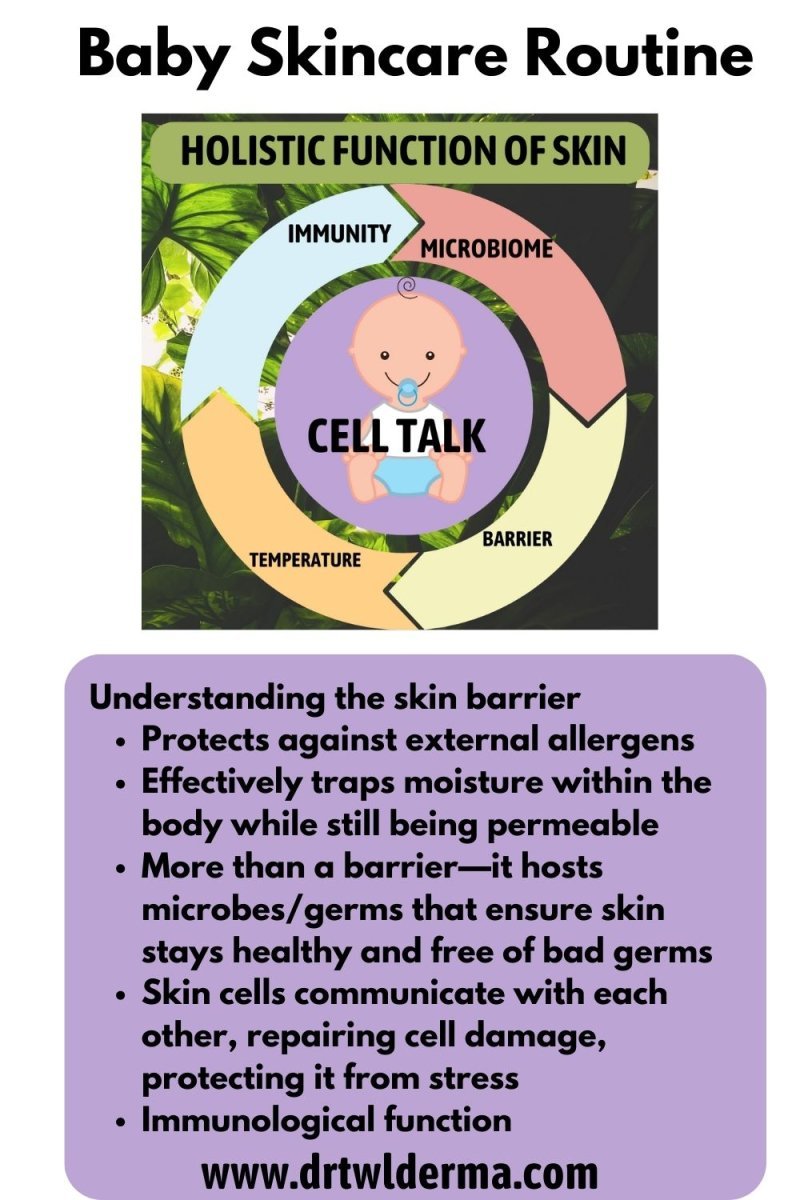
BEST BABY SKINCARE PRACTICES CHECKLIST 2
Ways to reduce trans-epidermal water loss
- Avoid long hours in air-conditioning unless in very hot weather
- Keep baby well-hydrated with fluids
- Choose a well-formulated moisturiser with the ideal composition of lipids, antioxidants and anti-inflammatory agents
- Moisturisers should contain a mixture of emollients in the following categories:
- Ceramides i.e. shea, synthetic ceramides
- Humectants i.e. glycerin, hyaluronic acid
- Occlusives (optional, may feel greasy in humid weather)
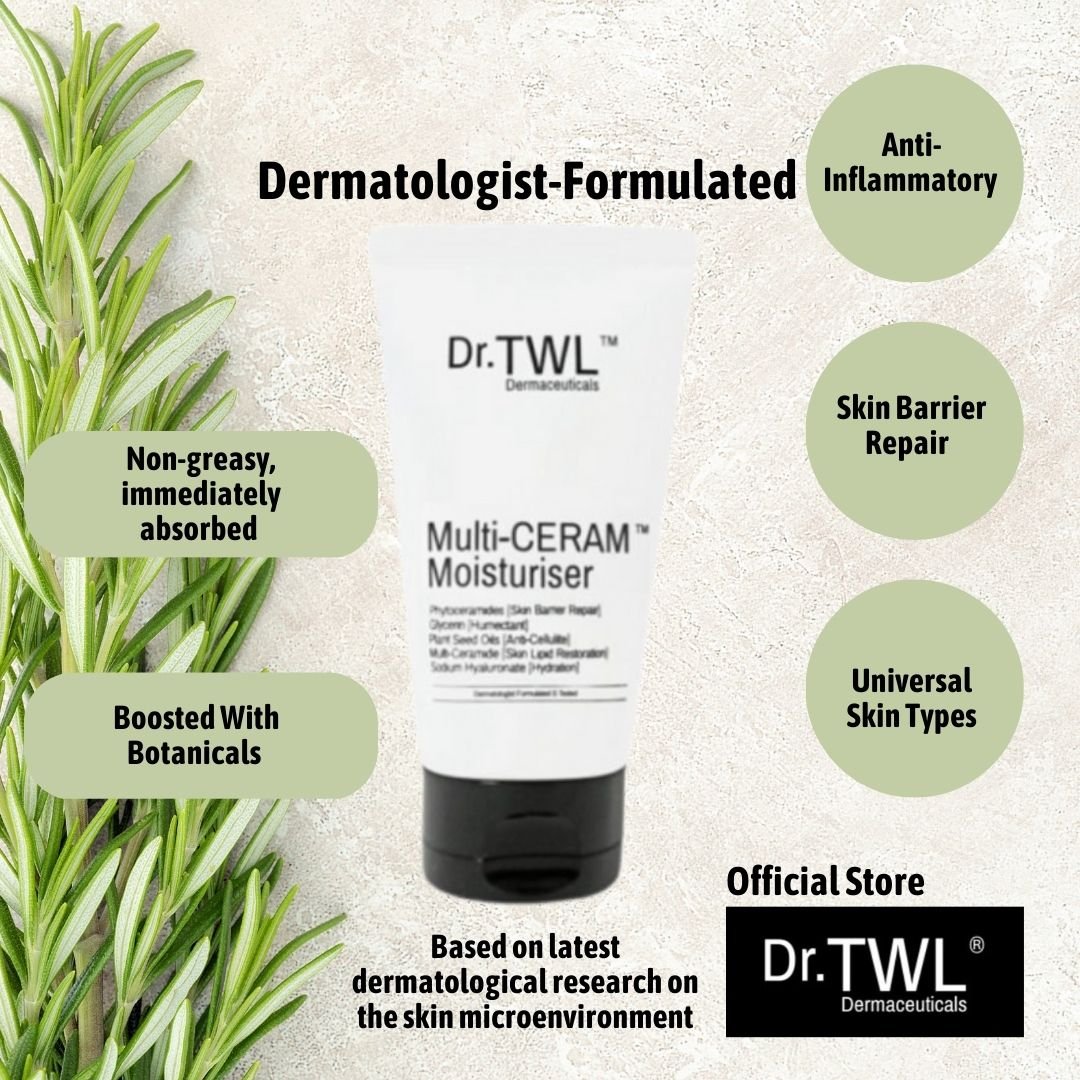
3. Increased moisture loss by evaporation
Transepidermal water loss is the process by which moisture is lost to the environment via evaporation. This is a problem in those with a damaged skin barrier i.e. eczema. However, as newborn skin is not fully developed, it lacks the intact skin barrier of older children and is more susceptible to TEWL.
4. Prone to frictional damage
We’ve touched on skin fragility but I would especially emphasise frictional damage. We take for granted things like the material of clothing we wear, even wiping our skin with towels or tissue paper. In baby skin, there can be detrimental effects on skin.
Some examples I highlight here:
A) Rough textured clothing
Wool, acrylic or polyester can feel prickly even to adult skin especially those with sensitive skin. The discomfort and irritation will be more pronounced on baby skin. It’s best to think of a newborn’s skin as lacking an outer layer protection afforded by fully developed skin. Hence, the clothes baby wears must literally feel as soft and comfortable as possible. Run the textile over the back of your hands for a quick test.
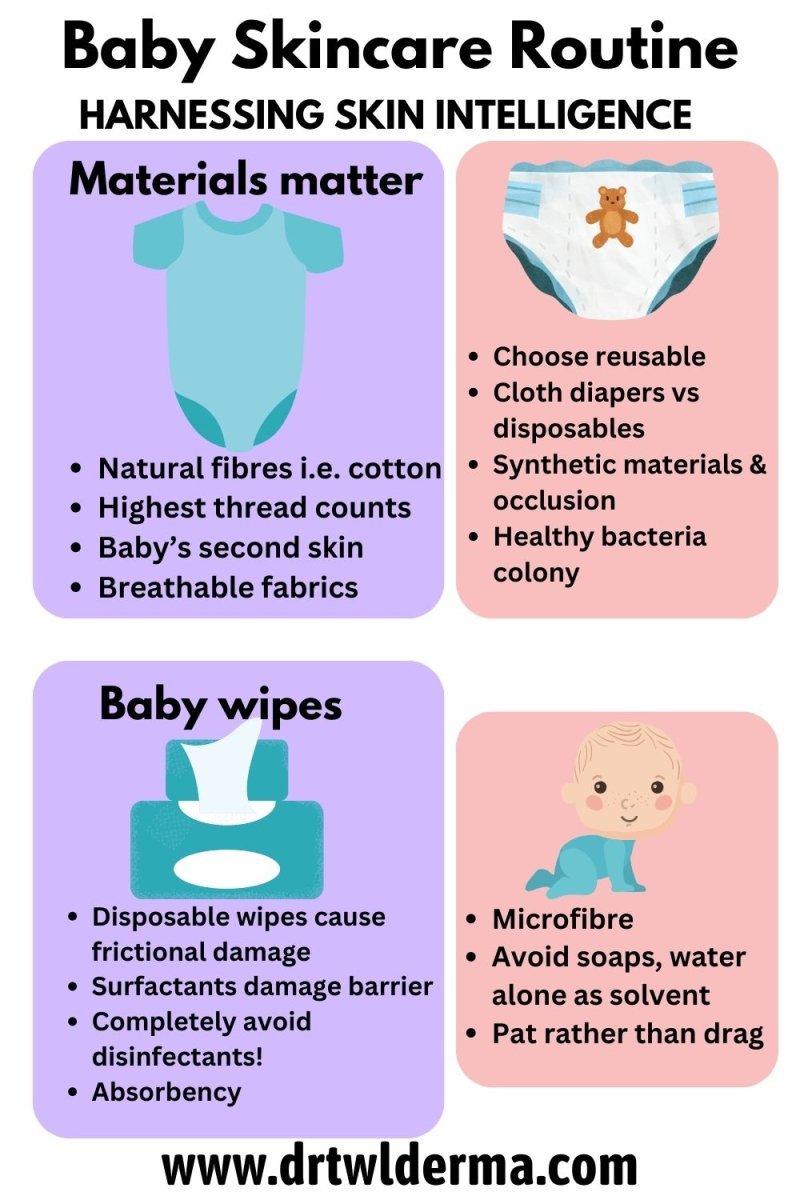
B) Wipes
We don’t think twice drying our skin with towels—but very often we are actually damaging our skin barrier when we rub our skin vigorously. Skin, when damp, is also more prone to damage. Pat baby’s skin dry with a soft microfibre towel which is more absorbent and softer to touch than traditional cotton fibres.
Don’t use dry tissues on baby skin—these are rather irritating and cause frictional damage.
Best Baby Skincare Practices
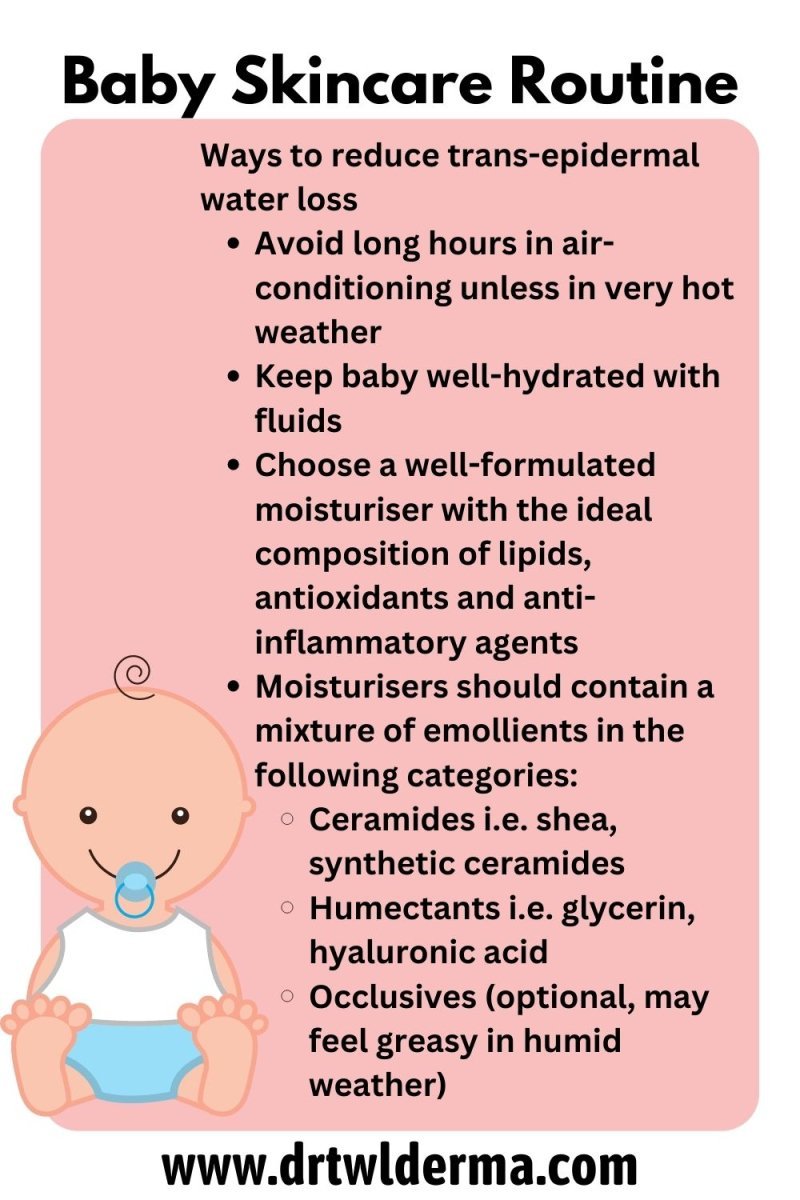
Choose textiles carefully
Opt for natural fibres such as cotton in the highest thread counts available to ensure softness and smoothness of the fabric. Textiles are quite literally baby’s second skin. If you live in warm climates, be aware of the concept of “breathability”, which means that the material and the design of the garment must allow air flow at the skin surface.
Reusable cloth diapers are better than disposables
Not just for the environment, but for baby’s skin too. The same principle of skin breathability applies to the nappy/diaper area. Disposable diapers made of synthetic materials can “suffocate” the skin by an occlusion effect—this increases the chance of skin irritation. The microclimate around skin also affects the growth of microorganisms. By allowing air circulation around the skin, you encourage the colonisation of skin by healthy bacteria, which protects skin from harmful infections such as yeast i.e. in candidiasis.
Baby wipes
Wipes are used to clean up soils and spills, but care must be taken as baby’s skin is fragile. Disposable wipes available commercially are typically made of a polyester blend which can cause frictional damage. Also, the wipes are usually infused with a surfactant for a cleansing effect which really isn’t necessary on a newborn’s skin. You would want to avoid disinfectants for sure, but chemical surfactants in general damage the skin barrier with repeated use. Disposable wipes are also not very absorbent. This effect is more pronounced on a newborn’s skin—as it is more fragile. So you definitely want to avoid that.
Reusable wipes made of soft microfibre are ideal as these are efficient materials which absorb soils/spillage readily. You also don’t need to use any soaps, water itself is a solvent and when used with a microfibre wipe is sufficient for cleansing baby’s skin.
The technique of wiping also matters more than you realise. In addition to using a soft fabric, try to pat rather than drag over skin as this increases frictional damage.
TOP TIP:
Use a hydrating mist for on-the-go cleansing for baby’s delicate skin. An essence infused with botanicals like rice bran, soy etc have natural cleansing properties which are gentle and soothing on a newborn’s delicate skin.
Building baby’s skin barrier from day 1
The skin barrier does not just form a physical barrier to protect our body from external allergens. It must be thought of as a living organism which like every organ in the body, communicates within itself and also signals to other organs. It traps moisture within but is still permeable, which means that it also continues to interact with the environment. This is where the concept of the skin microclimate comes in. This little ecosystem plays host to microbes/germs which help to ensure skin stays free of the bad guys. In many skin conditions, disturbances of the skin microbiome directly affects flare-ups. In eczema, the commonest childhood skin condition, sufferers are colonised with staphylococcus aureus, which causes a secondary skin infection known as impetigo.
Join the Baby Beauty community! This brand new newsletter written by board-certified dermatologist Dr. Teo Wan Lin, chief scientific officer of leading clinical skincare brand Dr TWL Dermaceuticals includes the latest buzz around the skin microbiome. You’ll get access to Dr.Teo’s expert pediatric dermatology tips, plus on-demand video workshops all year round. It’s free!
Who is this for?
- Moms, moms-to-be
- Those with a family or personal history of sensitive skin, eczema
- Nannies, carers
Encouraging skin resilience from birth
It’s important to cultivate skin health, it’s a lifelong commitment. With the right skincare routine, we can increase the skin’s innate resilience to infections, barrier damage and improve self-recovery. Skin is equipped with sensors like nerve endings and even the inflammatory response is designed to aid in recovery. When we fail to recognise signs of inflammation and irritation, that is when the problem starts. The same with the immune function of skin. We are not meant to live in a sterile environment, but at the same time, the newborn’s immune system is not fully developed. So a balance must be struck.
Remember, healthy skin cells communicate with one other. By sending signals it repairs cell damage, protecting it from stress and harmful germs. Skincare must be thought of as a way to recreate the ideal skin healing microenvironment to enhance beneficial processes.
Organic baby skincare
Organic is a term regulated by the USFDA and applicable to agricultural practices and foods. In the context of skincare, it is less meaningful. Organic skincare may be derived from pesticide-free raw materials, however it may contain inappropriate concentrations of essential oils or other additives that can irritate skin. The same applies for organic baby skincare.
Are organic baby skincare products the best ? Think again.
When searching for the best baby skincare products, choosing organic may not be a dermatologist’s priority. Here’s why. The term itself isn’t meaningful, as it does not account for other additives that must be included in a stable cosmetic formula i.e. one that does not grow mold or other harmful microorganisms. It really does not make sense either if the product is to be sold, if it were to be rapidly degraded much like fresh produce. For a skin product to have a reasonable shelf life—it should remain stable for 2-3 years at least. So many times it’s simply a case of the manufacturer taking advantage of the organic trend (which I fully support when it comes to one’s diet etc) which also happens to be an area not currently regulated by the cosmetic industry.
Get the best baby skincare tips explained by a board-certified dermatologist in your complimentary copy of the Baby Skincare Bible. How should I care for my newborn’s skin? How to watch out for signs of eczema in my child? If you find yourself wondering, this book is for you. The Baby Skincare Bible is a compilation of dermatologist tips on how to care for your newborn’s skin. This educational guide is written by board certified dermatologist and international microbiome expert in an easy to understand question and answer format. It contains concise answers to frequently asked questions about baby’s skincare plus a newborn baby tracker logbook.
How are baby skincare products different from adult skincare?
They can be the same. As is usually the case for dermatologist recommended gentle skin cleansers. These have the following in common:
- Low chemical surfactant concentrations
- Switch to alternative emulsifiers such as botanicals like soy, honey or amino acid surfactants
- Emollient i.e moisturising effect
- Important sign: does not leave skin feeling squeaky clean after cleansing
However, many adult skincare products do not have these properties. The reason being
- Cosmetic concerns i.e. the fully cleansed feel on skin is important for many and gentle skincare products can leave skin feeling sticky. This may also be uncomfortable in humid climates.
- Price point i.e. it is far more cost-effective for manufacturers to use chemical surfactants vs botanical alternatives
- Chemical surfactants also have a “foam” effect which many find important for a thorough cleansing experience
Subscribe to our newsletter Baby Beauty for the best baby skincare routines—recommended by our founder Dr Teo Wan Lin, board-certified dermatologist and chief scientific officer of Dr.TWL Dermaceuticals. Dr Teo shares the latest in skin microbiome research and barrier function—so you can begin building your child’s skin health from day 1. For a complete reference book on the A-Z of gentle baby skincare, get Dr. Teo’s book Baby Skincare Bible: A Dermatologist’s Guide. It is the one resource you need to understand how best to care for your baby’s skin to ensure that your child grows up having resilient and healthy skin.
Subscribe to Skincare Blueprint to get more skincare resources delivered to your inbox! Follow Dr TWL @drteowanlin on IG & Tik Tok.




